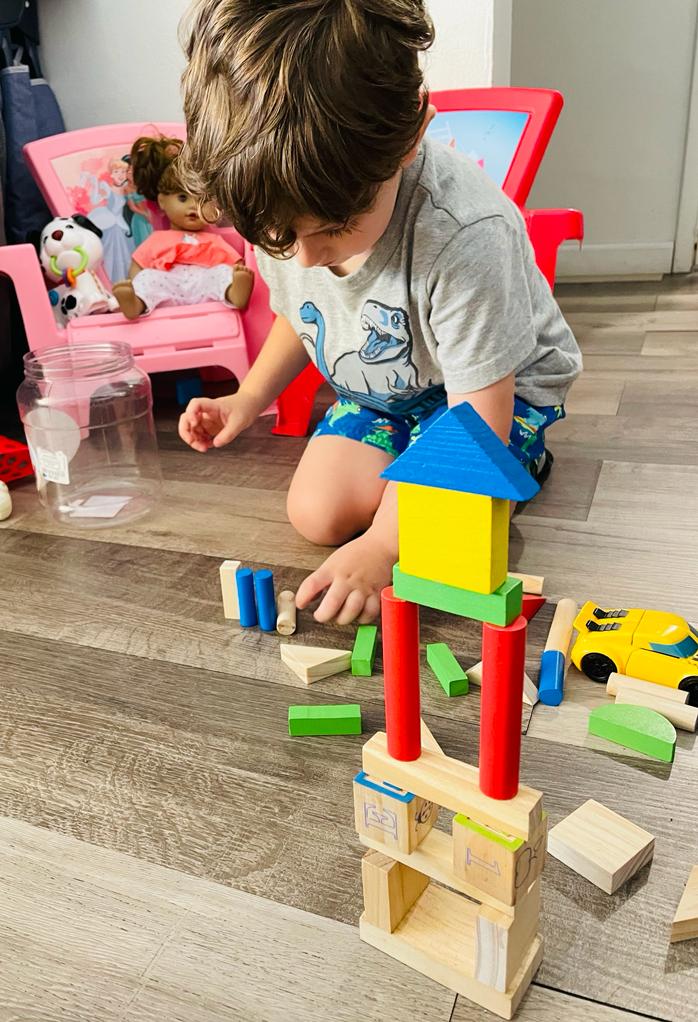Daniel asked me to make him a kitchen so he could make food for his Tata, not too long ago. We made the kitchen out of a cardboard box, we even invented an oven, while he cut toy vegetables and we went over their colors. He made the most of the meal and fed Margarita, the most spoilt doll in the house. Then, he burped her and laid down for her to sleep on his belly. We couldn’t even make a tiny bit of noise so she wouldn’t wake up.
Meanwhile, Emma prefers cars, the TV remote and dinosaurs to keep herself entertained. They both love building blocks and we make the tallest towers when we sit down to play.
All of the toys are in one place at home, even all the ones we make out of boxes and cardboard. They choose what they want to play with, while we improvise our everyday activities while trying to give them a respectful and different upbringing.
When I was a little girl, everything seemed homogeneous, but that was only at a surface level. In reality, people have been unique all our lives, but we used to hide our differences. We all wanted to be the same: be the same size, the same color, look the same, wear the same clothes, the same things, have the same sexual orientation.
Playing house, girls were the mothers who would look after the children, while the boys would play with cars and balls. If a girl did this, she would be called marimacha, a derogatory way to say that girls could only play with certain toys and take on certain roles.
Barbie dolls were white and skinny, and boys played with strong and powerful robots. This highlighted the homogeneity that would allegedly lead to something society would accept as “normal”. Differences were hushed up, as if they were deadly sins.
There are many gender-related stereotypes that have been normalized in many aspects of our lives today. One of them is the world of toys. They are often labeled or advertised as “toys for girls” or “toys for boys”. However, it’s essential we understand that toys don’t have a gender. It is vital that we encourage a play environment free of barriers that allows them to have fun and develop fully in childhood.
Role-play and games: the colors of a different childhood
Toys are tools for children to explore and learn, and they shouldn’t answer to any other purpose outside of this. By labeling and dividing toys based on gender, we reinforce stereotypes that can limit play options and children’s development.
The world of play is a space where the imagination and creativity flourish limitlessly. However, all too often, we find toys that are strongly linked to gender stereotypes and roles. Dolls and tea party games are labeled “toys for girls”, while cars and building blocks are considered “toys for boys”. This false division limits play options and creates a barrier in our children’s comprehensive development.
The same thing happens with colors. Blue has always been considered a “boy’s” color, while pink has always been a “girl’s” color. Ever since I was a little girl, I always liked green and I loved aquamarine, and I didn’t understand this division of colors. Now, as a mother, I enjoy seeing Daniel and Emma discover a world full of colors and choosing which they each like.
Playing is essential for children’s cognitive, emotional, and social development. Therefore, when we give our children different toys and we don’t limit ourselves to stereotyped options, we give them the chance to explore different skills, develop their creativity and broaden their horizons.
When toys are presented as gender-exclusive, it limits the way children see and experience the world. Girls might feel like they can only be interested in activities related to caregiving and beauty, while boys might feel discouraged from exploring emotions or skills considered “feminine”. This not only hinders their personal development, but also perpetuates gender inequality throughout their lives.
This is why it’s essential we offer children a wide range of toys and let them choose which ones they’re most interested in and drawn to.
As a result, we are opening up a world of possibilities to our children. Girls can explore science, technology, engineering and math with building games and scientific experiments. Meanwhile, boys can develop social and emotional skills by playing with dolls and role-play games.
We can’t forget that toys and role playing can influence the professions they choose in the future, as well as the skills they need to develop for self-care and looking after others.
Changes in toy creation
When we lived in Cuba, it was very hard to get toys for our curious kids. We had to improvise. That’s when I began making handicrafts, first for Daniel and then for Emma.
We’d go to the illicit market known as La Cuevita, in Havana’s San Miguel del Padro municipality. They sold really rustic plastic toys there, and it’s where we bought Daniel his first train and a wooden guitar.
Some small businesses also began to pop up which, given the absence of toys in state-controlled stores and high prices on the illicit market, sought to provide educational solutions so children can entertain themselves and also learn depending on their age and cognitive needs.
Lots of people have given the kids toys ever since we’ve arrived in the US; although I still have the tradition of making our own games with cardboard boxes turned into airplanes, trucks and kitchenettes.
I’ve also discovered here that products aren’t divided by gender here in stores and businesses, challenging firmly-rooted stereotypes and adopting a much more inclusive focus when it comes to organizing toys.
Instead of labeling toys for “boys” or “girls”, they are now being grouped by the skills they encourage, recommended age or the toy’s specific characteristics. There are more and more girls images in ads for building or as race car drivers, and boys washing up in the kitchen or represented as a doctor.
By developing and selling gender-neutral toys, businesses can contribute to a more equal and respectful society. This change isn’t enough and it seems slow, but at least it’s begun.
By organizing toys in a comprehensive way, without divisions, you’re giving children a much broader range of choice and encouraging them to explore different interests without feeling limited by their gender. This encourages an environment of fairer play and encourages the development of different skills.
Gender-neutral activities and toys
Building games and blocks: Building games, such as building blocks, LEGO or other similar sets, are excellent for developing motor skills, creativity and spatial awareness. They can also encourage teamwork and problem-solving.

Art and handicrafts: Handicrafts are essential for children to explore their creativity and express their imaginations via art. Watercolors, crayons, modeling clay, paper, cardboard… they can all be used by children to develop their artistic skills, while we encourage self-expression and self-confidence.

Role play and dress-up: We love to dress up at home. We recently recreated scenes from The Little Prince. Emma played the Little Prince and Daniel played the Fox, they both looked for the rose and drew their own moons. Role-play is an excellent way for children to develop their social and emotional skills, while also learning about different professions and the world in general.

Scientific games and experiments: It’s very important to encourage children’s interest in science, technology, engineering, and math from a young age. We explained how to make a volcano at home with bicarbonate and vinegar, or a microscope out of cardboard while we draw stars.
Board games and jigsaw puzzles: Board games and jigsaw puzzles are excellent to develop cognitive skills, strategy and teamwork. Even though Daniel and Emma are still young, we love jigsaw puzzles. We have our own board game fishing colored fishes and our “rap” to eat vegetables and sea of letters that helps us to make up words.
Sports and outdoor activities: It’s necessary to encourage physical activity and gender-neutral outdoor activities. Ever since Daniel was a little boy, in the middle of the COVID-19 pandemic, we used to run away to the farm that was a refuge for us, and he was happy in the mud collecting cabbages. Now, we live near the beach, we make the most of it to leave the house to go outside almost every afternoon. These activities promote health, physical development, and socializing. We all play soccer in the sand and run around tired, but happy.

Different toys and activities are crucial for children to be able to explore their interests and skills limitlessly. By giving them a wide range of options, we are encouraging an inclusive and open mindset from an early age. This will allow them to become empathetic and authentic adults, respectful of other people’s as well as their own differences, without complexes or fear. We need a real childhood, without ties, without preconceptions, to build a future like this.
This article was translated into English from the original in Spanish.









Comments
We moderate comments on this site. If you want to know more details, read our Privacy Policy
Your email address will not be published. Mandatory fields are marked with *